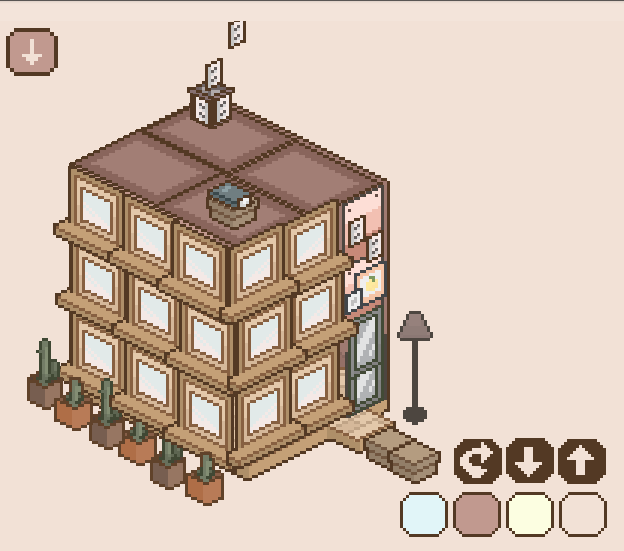Pixel Room Generator Mac OS
My son’s having trouble installing Pixelmon Mod to Minecraft on his Mac OS X El Capitan 10.11.1. He didn’t read a very nice guide on the pixelmonmod.com. You will need 3 files for this to work. – Java SDK 8u102 for Mac OS X 64. – Forge 1.8.9-11.15.1.1722 – Pixelmon 4.2.5-4.2.7. Whether it is Android smartphone, iPhone, PC, laptop with Windows, Linux, Mac OS or iOS, this universal tool works well across all platforms No App or tool installation As an image to pixel art conversion takes place on our secure cloud servers, you do not need to install any app or software. See the best Room Wallpapers HD Free download collection. If you see some Room Wallpapers HD Free download you’d like to use, just click on the image to download to your desktop or mobile devices.
MQL4 ReferenceConversion FunctionsColorToARGB
The function converts color type into uint type to get ARGB representation of the color. ARGB color format is used to generate a graphical resource, text display, as well as for CCanvas standard library class.
uint ColorToARGB( |
Parameters
clr
[in] Color value in color type variable.
alpha
[in] The value of the alpha channel used to receive the color in ARGB format. The value may be set from 0 (a color of a foreground pixel does not change the display of an underlying one) up to 255 (a color of an underlying pixel is completely replaced by the foreground pixel's one). Color transparency in percentage terms is calculated as (1-alpha/255)*100%. In other words, the lesser value of the alpha channel leads to more transparent color.
Returned value

Presenting the color in ARGB format where Alfa, Red, Green, Blue (alpha channel, red, green, blue) values are set in series in four uint type bytes.
Note
RGB is a basic and commonly used format for pixel color description on a screen in computer graphics. Names of basic colors are used to set red, green and blue color components. Each component is described by one byte specifying the color saturation in the range of 0 to 255 (0x00 to 0XFF in hexadecimal format). Since the white color contains all colors, it is described as 0xFFFFFF, that is, each one of three components is presented by the maximum value of 0xFF.
However, some tasks require to specify the color transparency to describe the look of an image in case it is covered by the color with some degree of transparency. The concept of alpha channel is introduced for such cases. It is implemented as an additional component of RGB format. ARGB format structure is shown below.
Pixel Room Generator Mac Os 7
ARGB values are typically expressed using hexadecimal format with each pair of digits representing the values of Alpha, Red, Green and Blue channels, respectively. For example, 80FFFF00 color represents 50.2% opaque yellow. Initially, 0x80 sets 50.2% alpha value, as it is 50.2% of 0xFF value. Then, the first FF pair defines the highest value of the red component; the next FF pair is like the previous but for the green component; the final 00 pair represents the lowest value the blue component can have (absence of blue). Combination of green and red colors yields yellow one. If the alpha channel is not used, the entry can be reduced down to 6 RRGGBB digits, this is why the alpha channel values are stored in the top bits of uint integer type.
Pixel Os Pc
Depending on the context, hexadecimal digits can be written with '0x' or '#' prefix, for example, 80FFFF00, 0x80FFFF00 or #80FFFF00.
Example:
//+------------------------------------------------------------------+ |
See also
Resources, ResourceCreate(), TextOut(), color type, char, short, int and long types
- ColorToARGB
How it works?
The process is very simple.
You click on Generate a HALD button to generate a PNG HALD.
You open this PNG into your favorite photo editing application and apply a color correction on the PNG HALD.
Then you save it as PNG without compression (or in JPG 100% quality).
Finally, you click Convert to CUBE and select the modified PNG you just saved.
The algorithm will interpret the differences that there are between each pixel of the original HALD and the HALD modified by you.
A 3D LUT as .CUBE format will be generated (25x25x25 or 64x64x64, choose in Preferences).
Convert Lightroom presets for video purpose
Use the power of Adobe Camera Raw on video
Create a LUT based on Photoshop color correction
Apply third-party app effects on video
Create your own 'LOG to Rec.709' LUTs
and so many other possibilities of uses...
Scroll down to discover some video tutorials about how to use.
Important note: A Look-Up Table (LUT) can only affect colors, contrast, brightness, gamma, etc.
So you can't add grain, noise reduction, vignetting, sharpen or any other dynamic effects.
If you apply this kind of elements on the PNG HALD, the output LUT may be corrupted!